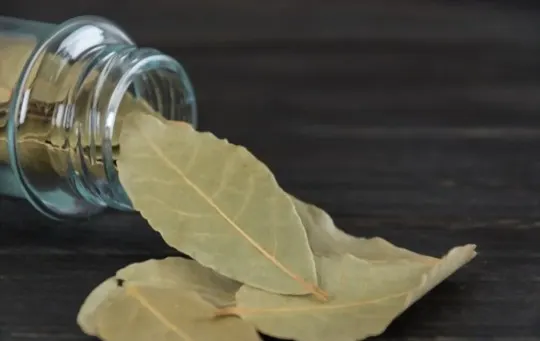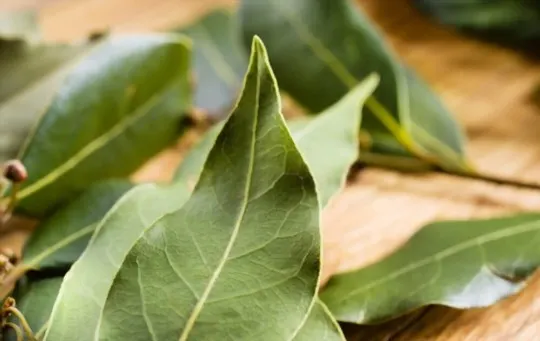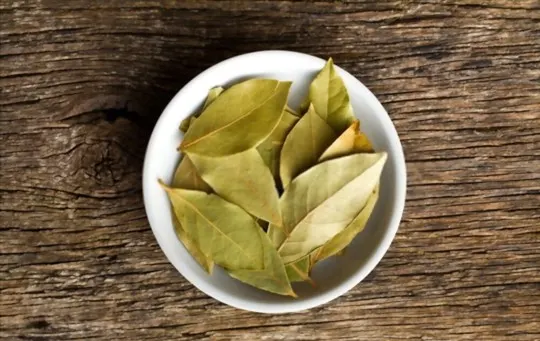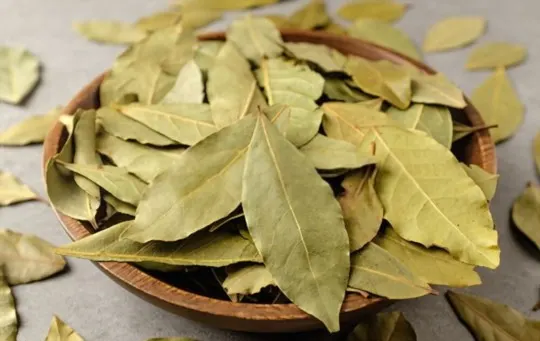Have you ever opened your spice cabinet and noticed a bag of bay leaves that have been there for longer than you remembered?
Do the dried herbs still look appetizing, or did they turn into something unrecognizable?
If so, you’re probably wondering: How long do bay leaves last and can they go bad?
The answer isn’t as simple as it may seem.
To help you get to the bottom of this culinary conundrum, especially if you don’t want to waste any of those savory-smelling fragrant delights, we’ll be exploring everything from shelf-life details to ideal storage conditions in this blog post.
Keep reading and soon enough, all your questions about these age-old flavor friends will be answered!
What’s Bay Leaf?

Bay leaves are a type of Laurel leaf that is often used as an herb in cooking.
These leaves come from the Bay Laurel tree, which is native to the Mediterranean region.
The leaves have a strong, slightly bitter flavor and are often used to add flavor to soups, stews, and sauces.
Bay leaves can be found fresh or dried in most supermarkets.
How Long Do Bay Leaves Last?

Bay leaves are a staple in many kitchens, but how long do they actually last? Bay leaves can lose their flavor relatively quickly – sometimes even before they’re dry.
If you’ve ever used a bay leaf only to find that it doesn’t have much flavor, it’s probably because it’s past its prime.
So how can you tell if a bay leaf is still good? The best way to test a bay leaf is to smell it.
If it doesn’t have much of a scent, it’s probably not going to add much flavor to your dish.
You can also give it a taste – if it’s bitter or unpleasant, it’s time to toss it out.
If you want your bay leaves to last as long as possible, store them in an airtight container in a cool, dark place.
This will help preserve their flavor and prevent them from drying out.
Bay leaves are a versatile ingredient that can add depth and flavor to many dishes.
But like all herbs, they eventually lose their potency and should be replaced.
By storing them properly and using them within a few months of purchase, you can make sure your bay leaves are always fresh and flavorful.
How Can You Tell If Bay Leaves are Bad?
If you’re not sure whether your bay leaves have gone bad, there are a few key things to look for.
First, check the color of the leaves.
If they’ve turned brown or black, they’re probably past their prime and won’t impart much flavor to your dish.
Second, take a sniff—if the leaves smell musty or unpleasant, it’s best to discard them.
Third, give them a feel—if the leaves are brittle or crumbly, they’re no longer fresh.
Once you’ve determined that your bay leaves are no longer fresh, you can still use them—you just need to adjust your cooking time accordingly.
For every fresh bay leaf called for in a recipe, use three quarter-sized dried leaves, or one whole dried leaf.
And be sure to add them early on in the cooking process so they have time to infuse their flavor into the dish.
What is The Best Way to Store Bay Leaves?

If you’re like most people, you probably have a few bay leaves hanging around your kitchen.
But do you know the best way to store them? Bay leaves can actually go bad if they’re not stored properly.
Here are a few tips to help you keep your bay leaves fresh:
- Store bay leaves in an airtight container. This will help to keep them from drying out and losing their flavor.
- Place the container of bay leaves in a cool, dark place. This will help to preserve their flavor and prevent them from going bad.
- If you’re not going to use the bay leaves right away, you can freeze them. Just be sure to place them in a freezer-safe bag or container before freezing.
Following these simple tips, you can be sure that your bay leaves will stay fresh and flavorful for a long time.
Can You Still Use Bay Leaves If They’ve Turned Brown?

If you’ve ever found a bay leaf in your spice cabinet that has turned brown, you may be wondering if it’s still safe to use.
The answer is yes.
Bay leaves are still safe to use even after they’ve turned brown.
The reason bay leaves turn brown is because of oxidation.
This is a natural process that happens to all herbs and spices over time.
When exposed to air, the leaves begin to break down and change color.
This doesn’t mean that the flavor has changed or that the leaves are no longer effective.
If you’re using bay leaves in a dish that will be cooked, there’s no need to worry about the color change.
The heat will cause the leaves to release their flavor just like they would if they were fresh.
If you’re using them as a garnish, you can simply remove the brown leaves before serving.
So, next time you find a brown bay leaf in your spice cabinet, don’t toss it out.
It’s still perfectly safe to use.
What Can You Do with Old Bay Leaves?

There are a few things that you can do with old bay leaves.
You can dry them out and use them as a spice, you can compost them, or you can use them to make a tea.
Drying out bay leaves is a great way to extend their shelf life.
Just place the leaves on a baking sheet and put them in a low oven for about an hour.
Once they’re dry, you can store them in an airtight container and use them as a spice.
Crumbling a dried bay leaf into soups or stews will give them a nice flavor.
Composting bay leaves is also a great way to get rid of them.
Bay leaves are high in carbon, which is important for the composting process.
Just make sure that you chop up the leaves before adding them to your compost bin.
You can also use bay leaves to make a tea.
This is said to have many health benefits, including helping with digestion and reducing inflammation.
To make the tea, just steep some dried bay leaves in hot water for 10 minutes.
Conclusion
Whether you’re a culinary novice or a seasoning pro, it’s always good to know how long your ingredients will last.
Bay leaves are no exception.
In this blog post, we’ll tell you everything you need to know about bay leaves – from how to tell if they’ve gone bad to what to do with them.
So next time you’re in the kitchen, you’ll be armed with all the bay leaf knowledge you need.

Carrie is a food writer and editor with more than 15 years of experience. She has worked for some of the biggest names in the food industry, including Bon Appétit, Food & Wine, and Martha Stewart Living.
As the Editor in Chief of IntroChicago.com, Carrie oversees all of the content on the site. She also manages the team of contributing writers and editors, who help to create delicious recipes, helpful tips, and informative articles that you’ll find on the site.
A native of the Chicago area, Carrie is passionate about all things food. She loves trying new restaurants and experimenting with new recipes in her kitchen. She’s also a graduate of the Culinary Institute of America, so she knows a thing or two about food!
